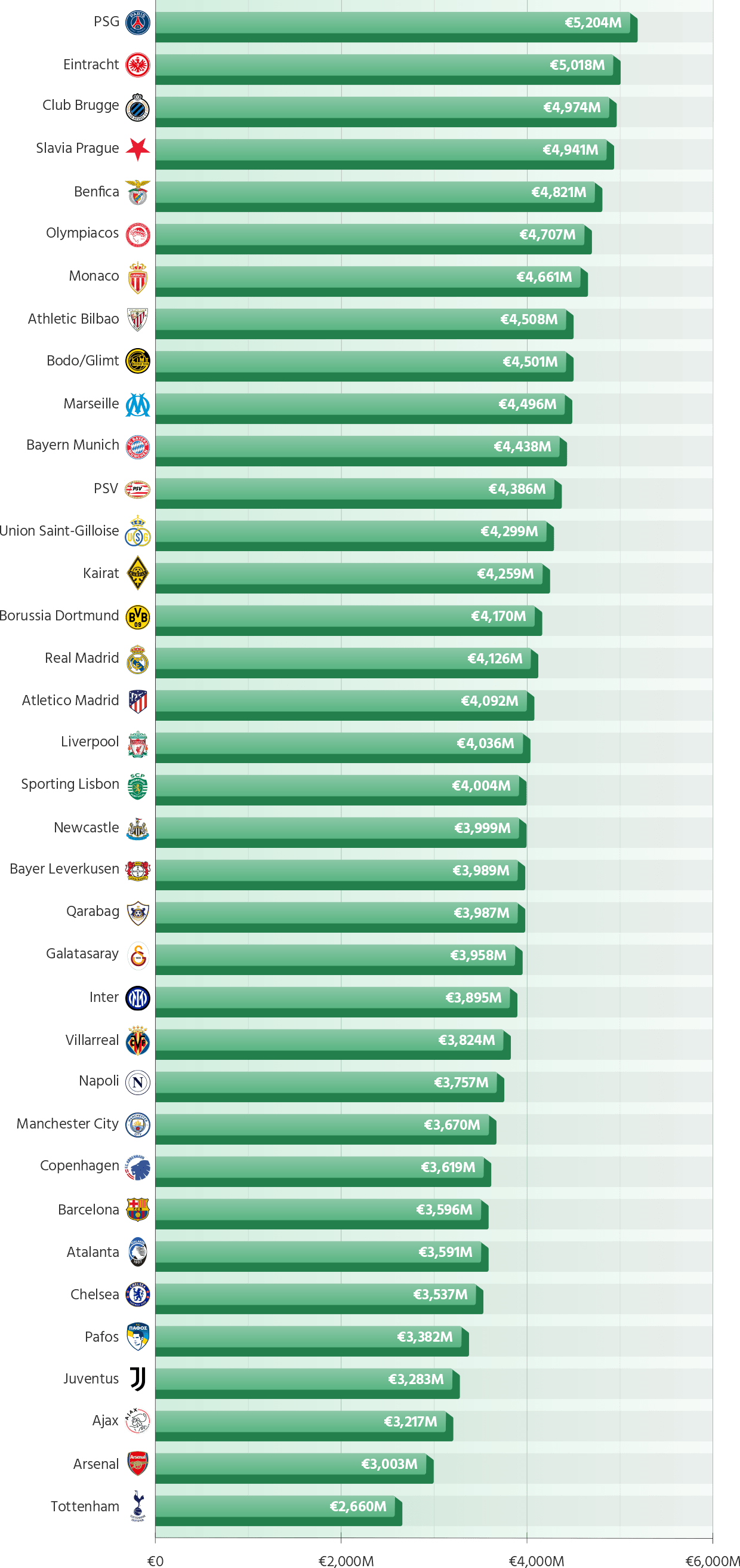The return of the Champions League league phase next week brings not just excitement, but a fresh debate about fairness. With every club handed a unique set of eight opponents, the race for the top eight, and knockout qualification, depends as much on the draw as it does on squad strength. For the purposes of our latest report, SportingPedia uses the combined market value of every club’s eight opponents as the defining measure of how difficult their path to the knock-out stage is.
The numbers reveal a massive gulf between the toughest and softest draws. For some, the path is lined with super-clubs. For others, a friendlier road awaits. One of the most curious insights is that two teams will face opponents worth over €5 billion, while one lucky club will play against sides worth less than €3 billion.
Champions League Fixtures Ranked by Opponents’ Combined Squad Value


Data Source: Transfermarkt
No team drew a more formidable set of opponents than reigning champions Paris Saint-Germain. Their eight adversaries – Bayern Munich, Barcelona, Atalanta, Bayer Leverkusen, Tottenham, Sporting Lisbon, Newcastle, and Athletic Bilbao – have a combined market value of €5,203.65 million. In effect, PSG must navigate a Champions League fixture list filled almost exclusively with European heavyweights, making their road to the knockouts statistically the most treacherous in the field.
Eintracht Frankfurt’s draw totals €5.02 billion, Club Brugge’s €4.97 billion, and Slavia Prague’s €4.94 billion – putting them all in the bracket with the most financially powerful set of opponents.
Benfica (€4.82B), Olympiacos (€4.71B), Monaco (€4.66B), Athletic Bilbao (€4.51B), Bodo/Glimt (€4.50B), and Marseille (€4.50B) also feature in the upper echelons for opponent value.
Other teams with high combined rival values include Bayern Munich (€4.44b), PSV (€4.39B), Union Saint-Gilloise (€4.30B), Kairat (€4.26B), Borussia Dortmund (€4.17B), Real Madrid (€4.13B), and Atletico Madrid (€4.09B).
The mid-range includes Liverpool (€4.04B), Sporting Lisbon (€4.00B), Newcastle United (€4.00B), Bayer Leverkusen (€3.99B), Qarabag (€3.99B), Galatasaray (€3.96B), Inter (€3.89b), and Villarreal (€3.82B).
Napoli (€3.76B), Manchester City (€3.67B), Copenhagen (€3.62B), Barcelona (€3.60B), Atalanta (€3.59B), and Chelsea (€3.54B) all have draws just under the average.
Towards the lower end, Pafos (€3.38B), Juventus (€3.28B), and Ajax (€3.22B) have schedules featuring less valuable opposition in market terms.
The lowest combined opponent values in the league phase belong to the North-London rivals Arsenal (€3.00B) and Tottenham (€2.66B), with the other London-based club – Chelsea (€3.54B) not far above. These figures mean that the London teams statistically face the least financially powerful set of rivals in this year’s draw. At the opposite end of the spectrum, Tottenham’s eight opponents have the lowest combined market value of all Champions League participants, totalling just €2.66 billion. No other team in the competition faces a fixture list with such a modest financial profile, at least by market value. This advantage makes Tottenham’s path unique, at least on paper. While every Champions League fixture list brings its own challenges, Spurs have drawn the least valuable set of rivals, providing an opportunity that is unmatched in this season’s league phase. Alongside fellow London clubs Arsenal and Chelsea, who also rank among the lowest for opponent value, Tottenham’s draw has delivered what is, numerically, the softest schedule in the entire competition.
This overview provides a data-driven context for each club’s draw, showing at a glance which clubs have the most valuable opposition – and which may see opportunity for progress.